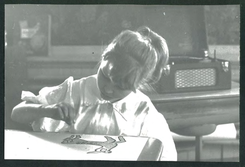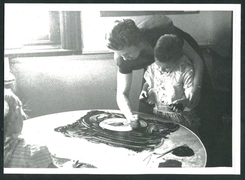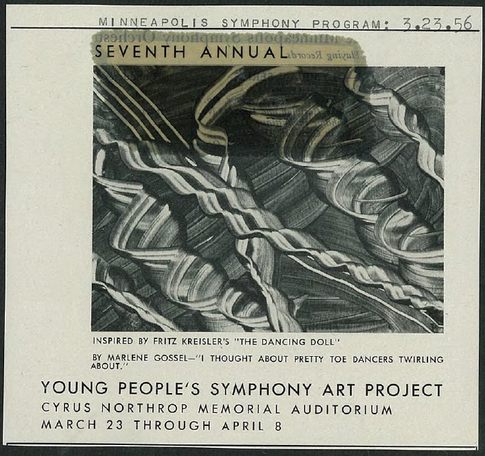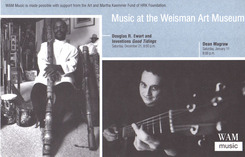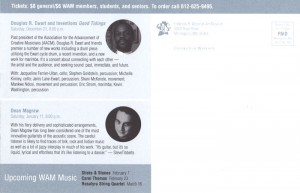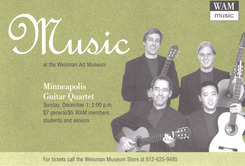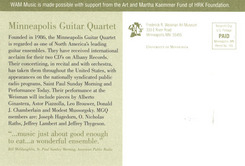Are you ever inspired by music? Are you a college student for whom a study session would be incomplete without “ear buds” habitually positioned in said ears and the latest up-and-coming sounds from emerging bands playing from your rotating playlist? (What are the kids listening to these days?) Are you an artist who prepares to paint/sculpt/etc. not only by setting out your materials and tools, but by also pressing play on your chosen audio transmitting device to start a carefully curated soundtrack to which you whistle to while you work? Musical inspiration and artistic creation was in the mind of Antal Dorati, director of the Minneapolis Symphony (known today as the Minnesota Orchestra) when he approached the Young People’s Symphony Concert Association (YPSCA) in 1949 with a proposed program titled, Symphony Art Project.
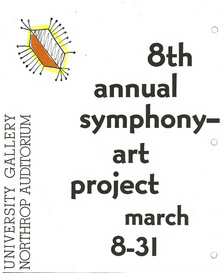 An official invitation to participate in the 1955-1956 season of the Symphony Art Project by the YPSCA dated November 21, 1955, indicates that “For the benefit of those who may be participating for the first time…” a description of Dorati’s impetus for creating the program is expressed: “to encourage a deeper sympathy and understanding for music in young people.” Dorati “suggested that one way to arouse [student] interest would be through their expression in art media of the ideas and emotions gained in listening first to ‘live music,’ whenever possible, and secondly to recordings and broadcasts.” (Original symphony recordings were provided to schools that could not send students to view a symphony concert in Northrop Auditorium.)
An official invitation to participate in the 1955-1956 season of the Symphony Art Project by the YPSCA dated November 21, 1955, indicates that “For the benefit of those who may be participating for the first time…” a description of Dorati’s impetus for creating the program is expressed: “to encourage a deeper sympathy and understanding for music in young people.” Dorati “suggested that one way to arouse [student] interest would be through their expression in art media of the ideas and emotions gained in listening first to ‘live music,’ whenever possible, and secondly to recordings and broadcasts.” (Original symphony recordings were provided to schools that could not send students to view a symphony concert in Northrop Auditorium.)
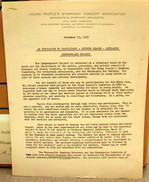 The invitation (at left) also provides additional background about the program, and includes rules and instructions for participation, noting that, “Pupils from kindergarten through high school may participate,” and that “This is not a contest.” The Young People’s Symphony Concert Association sponsored the annual program, and schools from across the metro area participated. Each school displayed the art created by their students within their own buildings, and teachers later selected a representative example of works produced by their students to be included in a spring exhibition at the University Gallery.
The invitation (at left) also provides additional background about the program, and includes rules and instructions for participation, noting that, “Pupils from kindergarten through high school may participate,” and that “This is not a contest.” The Young People’s Symphony Concert Association sponsored the annual program, and schools from across the metro area participated. Each school displayed the art created by their students within their own buildings, and teachers later selected a representative example of works produced by their students to be included in a spring exhibition at the University Gallery.
Clippings found in the University Gallery press books show the students in the midst of creating their music-inspired works:
Another clipping provides an example of student work. The Minneapolis Symphony program from March 23, 1956, shows a painting inspired by Fritz Kreisler’s musical arrangement, “The Dancing Doll.” The artist, student Marlene Gossel, described her inspiration, “I thought about pretty toe dancers twirling about.”
Though the Minnesota Orchestra is currently quiet, the organization still performs Young People’s Concerts and holds other education and outreach programs and activities to spread the appreciation of symphony music to all ages.
*(All of this symphony-izing has subsequently inspired me to search for and listen to arrangements I remember playing in combined orchestra in high school… Yahoo!)
